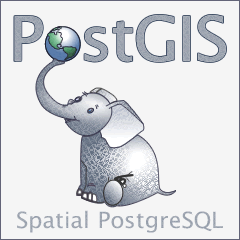PostGIS Downloads and Documentation
Refractions Research was originally the sole developer of PostGIS. Now that the project has grown and expanded, there is a large community of contributors and a Project Steering Committee that leads the project. All the latest software updates and documentation can be found at the community website Postgis.net
What is PostGIS?
PostGIS is a spatial database extension for the popular PostgreSQL object-relational database. PostGIS “spatially enables” the PostgreSQL server, allowing it to be used as a back-end spatial database for geographic information systems (GIS) and web-mapping applications in the same manner as Microsoft's SQL Server Spatial and Oracle's Spatial database extension.
PostGIS is an open-source project and PostGIS source code is released under the GNU General Public License (GPL).
PostGIS Features
High PerformancePostGIS uses the smallest possible representations of geometry and index structures to maximize performance. PostGIS users have compared performance with proprietary databases on massive spatial data sets and PostGIS comes out on top. Smaller data representations reduce throughput to slow hard-disks and keep data in fast memory cache, improving speed directly. |
Data IntegrityStoring spatial data in a database allows simple random access via any tool that can speak SQL: scripts, desktop applications, other databases, web services. PostGIS uses row-level locking to allow multiple processes to write to the spatial tables without resource contention and with guaranteed data integrity. |
Spatial QueryPostGIS includes a full set of geometry query operations: distance, containment, intersection, and full relationship matrices. In addition, queries are sped up by a self-tuning R-Tree index, fully integrated into the PostgreSQL query planner. |
Spatial AnalysisAdvanced GIS analysis can be carried out, using spatial joins, buffers, intersections, polygon building, line building, linear referencing, affine transforms and more! Because anything that speaks SQL can use the PostGIS functions, advanced GIS analysis can be leveraged by everything from scripts to J2EE applications. |
Support for Standards
Various versions of Postgis have been certified by the open geospatial consortium as compliant with the “simple features for sql 1.1” specification in the past. We no longer bother with the certifications of each new version as the specification is not changing anymore, so it is not worth the OGC fees to maintain every year. Postgis also implements much of the iso “sql multi-media” (sql/mm) standards for geospatial functionality.
Open Source Company
 Refractions sponsors and develops PostGIS as an open source
project in collaboration with developers from around the world.
Visit the PostGIS open source community site at
postgis.net.
Refractions sponsors and develops PostGIS as an open source
project in collaboration with developers from around the world.
Visit the PostGIS open source community site at
postgis.net.
Who's Using PostGIS?
- GlobeXplorer uses PostGIS to manage and save terabytes of satellite and image data on their high performance web site.
- Institut Géographique National (France's national mapping agency) stores the 100 million features of their high-resolution national basemap in PostGIS.
- The European Union Joint Research Centre stores and analyses shiptracks gathered in real time from radar satellites in PostGIS.
- IntoTerra manages metadata for petabytes of imagery in their photo collection, and holds 500 million geographic features from the Ordnance Survey of the UK in PostGIS.